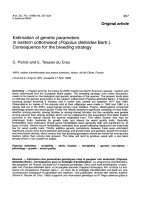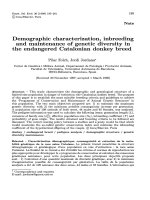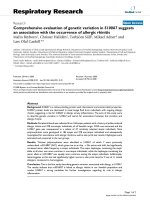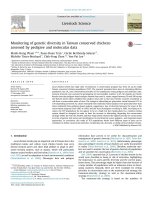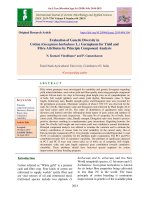Evaluation of genetic diversity in cotton (Gossypium barbadense L.) germplasm for yield and fibre attributes by principle component analysis
Bạn đang xem bản rút gọn của tài liệu. Xem và tải ngay bản đầy đủ của tài liệu tại đây (304.14 KB, 8 trang )
Int.J.Curr.Microbiol.App.Sci (2019) 8(4): 2614-2621
International Journal of Current Microbiology and Applied Sciences
ISSN: 2319-7706 Volume 8 Number 04 (2019)
Journal homepage:
Original Research Article
/>
Evaluation of Genetic Diversity in
Cotton (Gossypium barbadense L.) Germplasm for Yield and
Fibre Attributes by Principle Component Analysis
N. Kumari Vinodhana* and P. Gunasekaran
Tamil Nadu Agricultural University, Coimbatore-03, India
*Corresponding author
ABSTRACT
Keywords
Principle
component analysis,
Skewness, Kurtosis,
Eigen value,
Cumulative
variability
Article Info
Accepted:
20 March 2019
Available Online:
10 April 2019
Fifty cotton genotypes were investigated for variability and genetic divergence regarding
yield related attributes, seed cotton yield and fibre quality traits using principle component
analysis. Eleven traits viz., days to flowering, plant height (cm), no of sympodia/plant, no
of bolls, boll weight (g/plant), seed cotton yield (kg/ha), Micronnaire value, % Span
length, Uniformity ratio, Bundle strength (g/tex) and Elongation ratio were recorded for
the germplasm accessions. Maximum variation of about 17.0% CV was observed for the
traits No of bolls, Micronnaire value and Elongation ratio followed by Plant height (16.4)
and Seed cotton yield (15.23). The study of distribution of quantitative traits using
skewness and kurtosis provides information about nature of gene action and number of
genes controlling the traits respectively. The traits No of sympodia, No of bolls, Seed
cotton yield, Micronnaire value, Bundle strength, Elongation ratio were found to possess
positive skewness resulting in complementary gene interactions. Regarding kurtosis, the
traits No of bolls, boll weight and seed cotton yield were exhibited a normal distribution.
Principal component analysis was utilized to examine the variation and to estimate the
relative contribution of various traits for total variability. In the current study, Out of
Eleven principle components (PCs), five principle components revealed Eigenvalue >1 and
76.0% of cumulative variability for the attributes under examination. The PC1 and PC2
contributed towards 42% of cumulative variability. The attributes of significance depicted
in PC I and PC II were seed cotton yield, no of bolls, no of sympodia, boll weight,
micronnaire value and span length expressed great contribution towards cumulative
variability. These attributes should have bestowed special emphasis for cotton
improvement in future breeding program.
Introduction
Cotton referred as “White gold” is a premier
cash and fibre crop. Four kinds of cotton are
cultivated to supply worlds’ textile fiber and
are vital sources of oil and cottonseed meal.
Cultivated species include two diploids G.
herbaceum and G. arboreum, and two New
World tetraploids species, G. hirsutum and G.
barbadense. Gossypium barbedense is known
for its better fibre properties being cultivated
in less than 2% in the world. The basic
principle of cotton breeding is continuous
improvement in genetics of the available plant
2614
Int.J.Curr.Microbiol.App.Sci (2019) 8(4): 2614-2621
germplasm for creation of new genetic
recombinant with objectives of seed cotton
yield potential per unit area having acceptable
fibre quality under varying agro-climatic
conditions.
Cotton production either in seed yield or lint
depends on characters like plant height, direct
fruit bearing branches (sympodial) and
indirect fruit bearing branches (monopodial),
boll weight (BW), bolls per plant, seed index,
and ginning out turn (Salahuddin et al., 2010).
Seed cotton yield is a resultant product of all
its component traits and it could be enhanced
by exploiting positive influence of yield
components. Comprehensive understanding
about the crop nature, performance level and
association of numerous agronomic attributes
with yield is necessary for plant researcher to
tackle the cotton yield limiting constraints.
Multivariate biometrical techniques like
principle
component
analysis
(PCA),
Correlation Analysis and Clustering method
have been frequently used to explore genetic
diversity among genotypes and its direct and
indirect effects (Brown-Guedira et al., 2000).
Genetic variation of morphological traits
estimated through principal component
analysis has led to the recognition of
phenotypic variability. Keeping in view the
significance of genetic diversity, the present
research was conducted in G. barbadense
genotypes to explore the variability and
genetic divergence among cotton germplasm
for yield and fibre quality attributes.
Materials and Methods
A field experiment was carried out at
Department of Cotton, Tamil Nadu
Agricultural University, Coimbatore. The
germplasm collection consisting of 50 cotton
accessions used in this study were measured
for six quantitative characters viz., days to
flowering, plant height (cm), no of
sympodia/plant, no of bolls, boll weight
(g/plant), seed cotton yield (kg/ha) and five
fibre quality traits like Micronnaire value, %
Span length, Uniformity ratio, Bundle
strength (g/tex) and Elongation ratio. The
observations recorded on eleven traits were
analyzed in STAR statistical package to
explore the genetic divergence through
multivariate
analysis
among
cotton
germplasm for yield and fibre quality
attributes. The PCA analysis reduces the
dimensions of a multivariate data to a few
principal axes, generates an Eigen vector for
each axis and produces component scores for
the characters.
Results and Discussion
The first order statistics for the variables
measured for 50 cotton germplasm accessions
are given in the Table 1. Maximum variation
of about 17.0% CV was observed for the traits
No of bolls, Micronnaire value and
Elongation ratio followed by Plant height
(16.4), Seed cotton yield (15.23), Bundle
strength (12.77) and No of Sympodia (12.57).
Days to flowering has shown the least
variation with the CV% of 3.44.
Among the 50 genotypes, CCB 4, Seabrook
and NDGB 49 was observed to be early
flowering in about 63 days and NDGB 60 was
found to late flowering with the mean
flowering duration of 67 days. This trait
showed negative skewness (-0.17) and
kurtosis (-0.76). ICB 192 had the tall plant
height of 136.30 cm and the genotype NDGB
76 had the shortest plant type (63.3cm) with
the mean value of 101.00cm. This trait
showed negative skewness (-0.17) and
kurtosis (-0.76).
The number of Sympodia was found to be
more in ICB 100 (28.0) and less in ICB 134
(15.7) with the overall mean of 21.36. The
trait showed the positive skewness (0.38) and
2615
Int.J.Curr.Microbiol.App.Sci (2019) 8(4): 2614-2621
negative kurtosis (-0.05). The genotype
NDGB 33 found to have maximum number of
bolls (33.3) and ICB 367 had less no of bolls
(18.7). The mean number of bolls of the
genotypes was 23.45. The trait showed
positive skewness (1.14) and kurtosis (0.21).
Boll weight was found to be higher in ICB
365 (4.5) and lower in ICB 122 (3.3) with the
mean weight of 3.9g. The trait showed
negative skewness (-0.43) and positive
kurtosis (0.12). Seed cotton yield was found
to be highest in the genotype NDGB 28
(989.80) followed by NDGB 33 (976.5) and
NDGB 60 (935.6) and found to be lowest in
ICB 227 (570.4). The mean value of the
genotypes for seed cotton yield was 723.05
kg.ha. The skewness and kurtosis of the trait
are in positive direction.
NDGB 28 had the highest micronnaire value
of 6.8 while the genotype CCB4 had lowest
micronnaire value of 2.8 with the mean value
of 3.9. The trait had positive skewness (1.6)
and kurtosis (4.63). The genotype ICB 124
was found to have maximum Uniformity
Ratio (58.5) and Bundle strength (29.5) while
the genotypes ICB 204 (35.8) and ICB 188
(18.2) had the minimum value for the
respective fibre quality traits. The overall
mean of the genotypes for uniformity ratio
and bundle strength was 50.96 and 22.83
respectively. The trait Uniformity Ratio had
negative skewness (-1.11) and positive
kurtosis (4.63) while bundle strength had
positive skewness (0.38) and negative
kurtosis (052). The genotype CCB 4 had the
maximum Span length of 38.0 and the
genotype ICB20 had the minimum span
length of 24.3 with the mean value of 30.6.
Span length exhibited negative skewness and
positive kurtosis. The elongation ratio was
found to be highest in TCB 26 (4.90) and
lowest in CCB 4 (1.48). Both the skewness
and kurtosis are in positive direction.
Frequency distribution for different traits on
50 germplasm accessions revealed different
patterns of distribution as shown on Figure 1.
The study of distribution of quantitative traits
using skewness and kurtosis provides
information about nature of gene action and
number of genes controlling the traits
respectively. The skewed distribution of a
trait in general suggests that the trait is under
the control of non-additive gene action and is
influenced by environmental variables.
Positive skewness is associated with
complementary gene interactions while
negative skewness is associated with
duplicate (additive x additive) gene
interactions.
In this study, the traits No of sympodia, No of
bolls, Seed cotton yield, Micronnaire value,
Bundle strength, Elongation ratio were found
to possess positive skewness while the traits
days to flowering, plant height, boll weight,
span length found to have negative skewness.
The genes controlling the trait with skewed
distribution tend to be predominantly
dominant irrespective of whether they have
increasing or decreasing effect on the trait.
Kurtosis is important because it affects the
measure of dispersion we use to describe the
data in the distribution. In a platykurtic or flat
distribution, the variance and standard
deviation will be greater than in a normal or
leptokurtic distribution; this means that there
is more dispersion or variability in a
platykurtic distribution than in either of the
other shapes. In a leptokurtic distribution or
peaked distribution, the variance and standard
deviation will be less than in a normal or
platykurtic distribution; this means that there
is less dispersion or variability in a leptokurtic
distribution than in either of the other shapes.
Kurtosis is negative or close to zero in the
absence of gene interaction and is positive in
2616
Int.J.Curr.Microbiol.App.Sci (2019) 8(4): 2614-2621
the presence of gene interactions. The traits
with leptokurtic and platykurtic distribution
are controlled by fewer and large number of
genes, respectively. In this study, the traits
days to flowering, plant height, no of
sympodia, and bundle strength were found to
be platykurtic while the traits micronnaire
value, span length, uniformity ratio and
elongation
ratio exhibited leptokurtic
distribution. The traits No of bolls, boll
weight and seed cotton yield were found to
exhibit a normal distribution where the
variance and standard deviation will be
between those figures for a platykurtic or
leptokurtic distribution.
bundle strength (0.130), elongation ratio
(0.159) and boll weight (0.108) while
negative effects was observed for span length
(-0.03). The PC II revealed Eigen value of 1.8
Eigenvalue and 16.0% of variability. The
germplasm in PC II showed positive values
for span length (0.5757), seed cotton yield
(0.249), no of bolls (0.258), no of sympodia
(0.105), boll weight (0.024) while other traits
showed negative value. The PC III depicted
1.44 Eigen value and 13.0% of variability.
The germplasm in PC III presented positive
results only for the traits micronnaire value
(0.400), boll weight (0.228) and seed cotton
yield (0.053). The PC IV revealed 1.23 Eigen
value and 11.0 % of variability.
Principle component analysis
To explore the momentous variation among
fifty G. barbadense germplasm lines,
principle component analysis was used on
collected mean data of fibre quality, yield and
yield related attributes simultaneously.
Principal Component Analysis measures the
importance and contribution of each
component to total variance. It can be used for
measurement of independent impact of a
particular trait to the total variance whereas
each coefficient of proper vectors indicates
the degree of contribution of every original
variable with which each principal component
is associated. The higher the coefficients,
regardless of the sign, the more effective they
will be in discriminating between accessions.
In the current study, Out of Eleven principle
components (PCs), five principle components
revealed Eigenvalue >1 and 76.0% (Figure 1)
of cumulative variability for the attributes
under examination. The PC I depicted 2.83
Eigen value and 26.0% variability. The
germplasm in PC I exhibited positive effects
for seed cotton yield (0.512), no of bolls
(0.507), no of sympodia (0.378), micronnaire
value (0.337), uniformity ratio (0.296), days
to flowering (0.195), Plant height (0.186),
The germplasm in PC IV exhibited positive
effects for seed cotton yield (0.193), boll
weight (0.646), micronnaire value (0.066),
days to flowering (0.124) and uniformity
raitio (0.044). The PC V depicted 1.03 Eigen
value and 9.00 % of variability. The
germplasm in PC V presented positive values
for boll weight (0.391), Micronaire value
(0.068), span length (0.270) and plant height
(0.305) while other traits had the negative
values (Table 2).
The PC1 and PC2 contributed towards 42% of
cumulative variability. The attributes of
significance depicted in PC I and PC II were
seed cotton yield, number of bolls, number of
sympodia, boll weight, micronnaire value and
span length expressed great contribution
towards cumulative variability.
These attributes should have bestowed special
emphasis for cotton improvement in future
breeding program. Previous findings of these
attributes depicting their contribution towards
cumulative variability and future cotton
improvement programs were also reported by
Saeed et al., (2014), Kaleri et al., (2015),
Latif et al., (2015) and Shah et al., (2018).
2617
Int.J.Curr.Microbiol.App.Sci (2019) 8(4): 2614-2621
Table.1 Characteristic Means and Variations for 50 Cotton Accessions
Variable
DTF
PH (cm)
SYM
NB
BW (g)
SCY (kg/ha)
MV
SL (mm)
UR
BS (g/tex)
ER
Mean
67.32
Min
63
Accessions Max Accessions StdDev CV
CCB 4,
72
NDGB 60
2.32
3.44
Seabrook,
NDGB 49
100.9 63.3
NDGB 76 136.3 ICB 192
16.55
16.4
21.36 15.7
ICB 134
28.0
ICB 100
2.68
12.57
23.45 18.7
ICB 367
33.3 NDGB 33
4.02
17.14
3.9
3.3
ICB 122
4.5
ICB 365
0.25
6.41
723.05 570.4 ICB 227
989.8 NDGB 28 110.15
15.23
3.9
2.8
CCB 4
6.8
NDGB 28
0.7
17.95
30.65 24.3
ICB 20
38
CCB 4
2.5
8.14
50.96 35.8
ICB 204
58.5
ICB 124
4.54
8.92
22.83 18.2
ICB 188
29.5
ICB 124
2.92
12.77
7.3
4.6
CCB 4
12.4
TCB 26
1.31
17.91
DTF: Days to flowering; PH: Plant height; SYM: No of sympodia; NB: No of Bolls; BW: Boll weight; SCY:
Seed cotton yield; MV: Micronnaire value; SL: Span length; UR: Uniformity ratio; BS: Bundle strength; ER:
Elongation ratio
Table.2 Eigenvalues, percentage of variability, cumulative variability and attributes that
contributed towards principle components
Statistics
Standard deviation
Proportion of
Variance
Cumulative
Proportion
Eigen Values
Variables
DTF
PH
SYM
NB
BW
SCY
MV
SL
UR
BS
ER
PC1
1.68
0.26
PC2
PC3
PC4
PC5
1.34
1.2
1.11
1.02
0.16
0.13
0.11
0.09
0.26
0.42
0.55
0.66
0.76
2.83
PC1
0.1957
0.1868
0.3786
0.5072
0.1088
0.5187
0.3376
-0.0324
0.2966
0.1306
0.159
1.8
PC2
-0.2924
-0.1041
0.1054
0.2583
0.024
0.2494
-0.2223
0.5757
-0.1125
-0.0196
-0.6076
1.44
PC3
-0.2627
0.0435
0.1712
-0.0208
0.2281
0.0533
0.4005
-0.2125
-0.3235
-0.7249
-0.0939
1.23
PC4
0.1246
-0.6378
-0.2884
-0.0276
0.6469
0.1938
0.0662
-0.115
0.044
0.1246
-0.0526
1.03
PC5
-0.437
0.3563
-0.1845
-0.2213
0.3915
-0.0808
0.068
0.2708
0.5836
-0.0594
0.1311
2618
Int.J.Curr.Microbiol.App.Sci (2019) 8(4): 2614-2621
Fig.1 Frequency distribution of 50 germplasm accessions showing different patterns of
distribution
SL
ER
NB
SCY
SYM
PH
\
2619
Int.J.Curr.Microbiol.App.Sci (2019) 8(4): 2614-2621
Fig.2 Biplot between PC1 and PC2 depicting the extent of variation
Fig.3 Score plot of fifty cotton genotypes
Fig.4 Scree plot showing Eigen value variation
The score plot (Figure 3) scattered the
germplasm based on the existence of significant
genetic variation (Liaqat et al., 2015). The
distance from the origin of plot and germplasm
displayed the level of genetic divergence of
germplasm i.e., greater distance showed
significance diversity among germplasm and
vice versa (Rana et al., 2013). Genetic diversity
among germplasm may not rely only on their
geographical distribution but also on numerous
2620
Int.J.Curr.Microbiol.App.Sci (2019) 8(4): 2614-2621
factors like environmental variability, exchange
of hereditary material, genetic drift and natural
and artificial selection (Bates et al., 1973).The
results of present experiment were in greater
accordance with Latif et al., (2015) and Khan et
al., (2015). The score plot produced in principle
components analysis diversified the fifty
germplasm based on their genetic pattern
(Figure 2).
The outliers ICB 20, ICB 227, TCB 26, CCB4
resulted as most divergent germplasm. On the
other hand, some germplasm was present very
close to the origin of polygon and supposed as
being genetically similar and minimum genetic
divergence due to their narrow genetic bases.
Principal component analysis has identified few
characters that plays prominent role in
classifying the variation existing in the
germplasm set. The analysis identified seed
cotton yield no of bolls, no of sympodia, boll
weight, micronnaire value and span length in
different principal components are the most
important for classifying the variation.
Thus the results of principal component analysis
used in the study have revealed the high level of
genetic variation existing in the population
panel and explains the traits contributing for
this diversity. Hence the results will be of
greater benefit to identify parents for improving
various morphological traits analyzed in this
study.
References
Kaleri, A.A., S.Y. Rajput, G.A. Kaleri and J.A.
Marri. 2015. Analysis of Genetic diversity
in genetically modified and non-modified
cotton
(Gossypium
hirsutum
L.)
How to cite this article:
genotypes. J. Agric.Vet. Sci. 8(12): 70-76.
Khan, F.Z., S.U. Rehman, M.A. Abid, W. Malik,
C.M. Hanif, M. Bilal, G. Qanmber, A.
Latif,
J. Ashraf and U. Farhan. 2015. Exploitation of
germplasm for plant yield improvement in
cotton (Gossypium hirsutum L.). J. Green
Physiol. Genet. Genom. 1(1): 1-10.
Latif, A., M. Bilal, S.B. Hussain and F. Ahmad.
2105. Estimation of genetic divergence,
association, direct and indirect effects of
yield with other attributes in cotton
(Gossypium hitsutum L.) using biplot
correlation in and path coefficient
analysis. Tropical Plant Res. 2(2): 120126.
Liaqat, S., R.I. Ahmed, S. Ahmad, M. Bilal, A.
Karim, A. Qayyum, R.T. Ahmed and M.
Rafiq 2015. Evaluation of diverse
germplasms of cotton (Gossypium
hirsutum L.) for yield and fibre attributes
by multivariate analysis approach. J.
Agric. Sci. Rev. 4(5): 146-150.
Rana, R.M., S. Rehman, J. Ahmad and M. Bilal.
2013. A comprehensive overview of
recent advances in drought stress
tolerance research in wheat (Triticum
aestivum L.). Asian J. Agric.Biol. 1(1):
29–37.
Saeed, F., J. Farooq, A. Mahmood, M. Riaz, T.
Hussain and A. Majeed. 2014.
Assessment of genetic diversity for cotton
leaf curl virus (CLCuD), fibre quality and
some morphological traits using different
statistical procedures in Gossypium
hirsutum L. Aust. J. Crop Sci. 8(3): 442447.
Shah, A.S., Khan, J.S, Ullah.K1 and Sayal, O.U.
2018. Genetic Diversity in Cotton
Germplasm using Multivariate Analysis.
Sarhad Journal of Agriculture, 130-135.
Kumari Vinodhana, N. and Gunasekaran, P. 2019. Evaluation of Genetic Diversity in Cotton
(Gossypium barbadense L.) Germplasm for Yield and Fibre Attributes by Principle Component
Analysis. Int.J.Curr.Microbiol.App.Sci. 8(04): 2614-2621.
doi: />
2621

